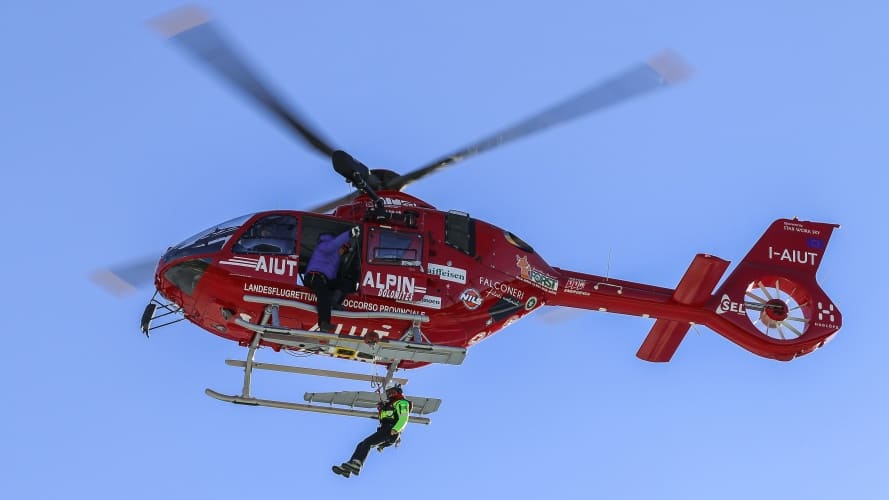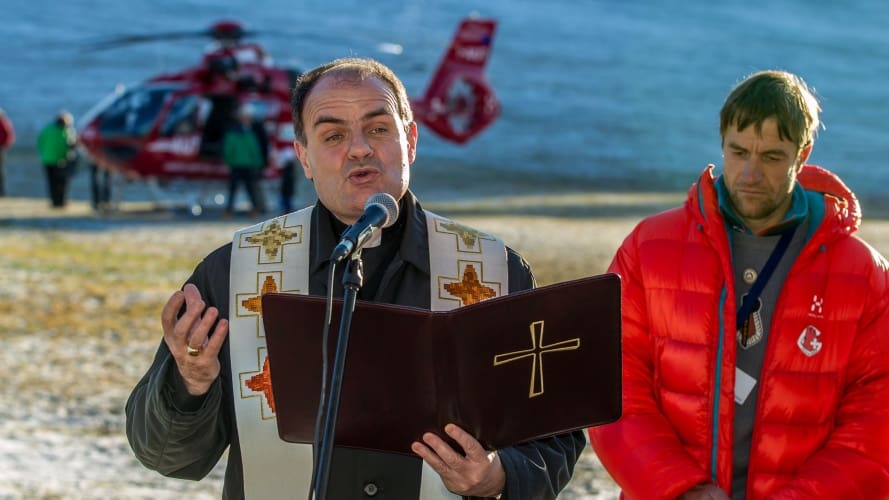The twisted peaks and pinnacle ridges of northern Italy’s Dolomite mountains formed a stunning backdrop for the entry into service of the latest iteration of Airbus’s lightweight, twin-engined helicopter, the EC135, earlier this week.
Stunning and fitting, because the EC135 T3 is going into service with the Dolomites mountain rescue service, Aiut Alpin Dolomites, which works to help skiers, climbers and hikers in difficulty throughout the year in the dramatic mountains. Helicopters are vital for mountain rescue, explained Aiut Alpin chief medic Lydia Rauch, because they allow injuries to be treated on the scene of the incident or during transit to a hospital. ‘Before we used helicopters, far too many of our patients died, either before we reached them or soon after we started taking them off the mountain, because the sort of injuries we frequently see, broken femurs and hips and abdominal crush injuries, cause internal bleeding. Now we can reach people much faster and have a stable platform to treat them.’
The new P3 has adaptations which make it even better suited to mountain rescue applications than its predecessor, the T2i; it has a wider main rotor and has shifted the air intakes for the main engine from the front of the aircraft, above the cockpit, to the sides. These changes, although slight and barely noticeable unless you have both models in front of you and know what to look for, allow for a significant increase in power and improve the helicopter’s performance in hover mode and at high altitude – particularly important in mountain rescue in the Dolomites, where flat ground is a rarity and rescues often have to be carried out with the helicopter hovering throughout.

Even more hair-raising are fixed-line rescues, where the medic or mountain specialist (rescue missions always fly with both) has to dangle below the helicopter on a climbing rope and be swung in to reach a patient below the underhanging slopes that are common in these mountains. The swinging impetus is imparted and controlled entirely by the helicopter pilot, and fine control in hover is vital.
The only other visible changes to the helicopter are slight alterations to the stabiliser blades on either side of the tail — they no longer have vertical endplates — and a slightly different configuration of the tail rotor housing. In the cockpit, the pilot controls the aircraft via a modern ‘glass cockpit’ with integrated display screens rather than dials, similar to those found in the latest airliners; the aircraft also uses digital flight control software with integrated avionics for navigation and communication. The helicopter cabin can be fitted out to accommodate two stretchers as well as the pilot, anaesthetist, winch operator, mechanic and mountain rescue specialist that fly on all missions.
’It’s fair to say that helicopters often lead in terms of technology innovation
Johannes Plaume, Airbus Helicopters, EC135 series chief engineer
‘Helicopters have many of the same engineering issues as mainstream aerospace,’ explained Johannes Plaum, chief engineer of the EC135 series. ‘It’s always about saving weight and improving availability of power. But helicopters pioneered use of composites before fixed-wing aircraft. It’s fair to say that helicopters often lead in terms of technology innovation.’
One reason for this is that by their nature helicopters are multifunctional beasts. ‘Most fixed-wing aircraft, especially the type that Airbus builds, fly the same mission profile every time; they take off, the climb to a cruising altitude, they stay there for most of the flight, then they land. That’s not true for helicopters. They’re less of a means of transport and more of a working platform; they work in a very wide variety of landscapes, situations and weather conditions. Even within a single series like EC135, you can’t design for a typical mission profile because there isn’t one. Very often, the crew doesn’t even know what they’re going to have to deal with even when they take off.’
Flying in the EC135 T3 is an unsettling experience, especially if, like your distinctly unintrepid reporter, you’ve never set foot in a helicopter before and you’re lousy with heights. The take-off is so gentle as to be completely unnoticeable, until you suddenly realise that the cabin is swinging around rather fast, the helipad is receding rapidly and the nose is pointing downwards. The cabin seats four comfortably and although there isn’t anything to grab hold of, feels secure even when the pilot chooses to demonstrate the aircraft’s manoeuvrability by banking steeply between two peaks to access the plateau area where the helicopter’s inauguration was to take place. I disembarked intact but wobbly-legged to be greeted by one of Aiut Alpin’s solicitous mountain rescue dogs who’d obviously sensed my discomfort. The dogs fly on missions when there is a danger of avalanche and are trained from a young age to cope with the noise and motion of the helicopter flight. I can only imagine what it must be like in a helicopter flying over the mountains with a scared puppy early in the training.

Plaum believes that, like with fixed-wing airliners, the general design of helicopters is unlikely to change in the near future. ‘We know that the main rotor, cabin, tail rotor configuration works, we understand it well, and building on that allows us to get new models into service more quickly and safely,’ he said. ‘The last big paradigm change in rotorcraft was tilt-rotors, and there’s really only the Boeing Osprey, which has one main client — the US Marines — and getting into service was extremely painful.’ But this dosen’t mean there’s no room for innovation. New composites enabled the design of the P3’s larger rotor, whose blades twist to change their angle of attack into airflow rather than pivoting and are therefore free from bearings; ‘That reduces the number of components and makes maintenance far easier,’ Plaume said.
The new T3 certainly has a higher power looking out for it: part of the inauguration was a lengthy blessing from a bishop in Ladino, the local dialect (a fully-enrobed bishop blessing a helicopter is one of the more surreal events I’ve witnessed in my journalistic career). Nobody knows a word of Ladino 20 minutes down the road, commented one Aiut Alpin member, but the mountains understand.




Poll: Should the UK’s railways be renationalised?
I _do_ remember British Rail - and that it was <i>literally</i> a national joke https://youtu.be/zV2lmSDKvO8